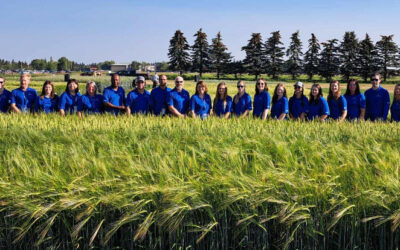The following piece is from our sister publication, Germination.
Whether it’s paying mind to wheat classes or looking at third-party testing of vicine/convicine in faba bean, the Prairie Grain Development Committee has the consumer in mind.
The University of Saskatchewan’s new flax breeder got to put forward his first flax line this year at the annual meeting of the Prairie Grain Development Committee (PGDC). Bunyamin Tar’an, who took over for Helen Booker as the USask flax breeder in 2020, saw the flax line FP2591 recommended for registration this year.
The brown-seeded line spent three years in co-op trials and sports a yield 5-6% higher than CDC Glas. FP2591 was the highest yielding line in the last three years of co-op trials. Tar’an says he looks forward to releasing more in the next couple of years, including some yellow-seeded flax lines.
“Yellow-seed flax seems to be more appealing for the consumer,” he says. “Instead of seeing a brown seed in your bread, for example, a yellow seed imparts a nice golden colour and can be little bit more appealing.”
That kind of forward thinking was on full display this year at the PGDC meetings. A major theme during the plenary session was designing the seed system of the future: updates were provided on Seed Regulatory Modernization (SRM) and changes to Canada’s novel food regulations, which are currently under review by the Canadian Food Inspection Agency after Health Canada recently issued new guidance on them.
Under Health Canada’s new guidance, many foods derived from gene edited plants will not be considered novel, opening the door for breeders to use new techniques to create new crop varieties. But it was more than just breeding itself that was on the minds of attendees this year.
As breeders are now able to breed new lines to better meet the needs of the market, those same breeders have to be able to show their line meets those needs in order to be successfully commercialized. A case in point is faba bean. While the faba bean plant is high in protein, well-suited to growing in colder climates, and capable of virtually eliminating the need for fertilizer, it has one fatal flaw — for an estimated 400 million people worldwide, eating the bean can have severe health consequences.
In people deficient in a certain enzyme, consuming faba bean causes damage to a person’s red blood cells due to the naturally occurring compounds vicine and convicine. As a result, breeders are meeting demand for low vicine/convicine faba beans, which could be a new, high-value crop for farmers.
Last year was the first time breeders of faba beans had to prove that their faba bean line contains low vicine levels in order to enter into faba bean trials.
“Something we are grappling with is if there’s a need for unbiased third-party testing of this material before we can vote on and provide a true recommendation. Transparency in data sets is hugely important. The last thing we want to do is make a recommendation on a line that doesn’t meet our specs,” says Glen Hawkins, chair of the Prairie Recommending Committee for Pulses and Special Crops (PRCPSC).
In the next five to seven years, Canada’s faba bean acreage on the Prairies will hopefully consist of 100% low vicine lines, Hawkins said. It’s the kind of big-picture thinking that’s becoming more prevalent as the agricultural industry in Canada looks to become even more competitive on a global scale.
The PRCPSC saw a record 34 lines looked at this year: nine dry bean lines, nine lentil lines, 10 field pea lines, one specialty pea line (the first winter pea ever recommended), and five faba bean lines. One pea line was rejected, making for a total of 33 lines recommended for registration. The high number of field pea lines is due to the surge in opportunities in the plant-based protein sphere, Hawkins said.
Meeting end user demand was also high on the agenda of the Prairie Recommending Committee for Wheat, Rye and Triticale (PRCWRT). This year saw discussion on something first brought up two years ago — the need for a common set of checks designed to make it easier to allocate varieties to the right end use test.
“Right now, a breeder usually has a fairly good idea of where they think their line should fit based on its breeding and performance in the early level tests, but there are times where the quality evaluation team reviews the data and says it’s got a better fit in another class,” says Dana Maxwell, chair of the PRCWRT.
“So, the breeder ends up moving it and it gets tested in the other class. We’re trying to find ways to make that a bit easier.”
The answer comes in the form of crossover checks, which serve as common checks that will allow lines to be referred back and forth between classes during co-op trials. This makes it much easier for the quality evaluation team to look at the long-term performance of the variety. The PRCWRT looked at a report from its check subcommittee, which included a preliminary review of a project looking at a common set of Hard Red Spring check varieties that could support more efficient operations in the HRS categories (CWRS, CPS, CNHR) in the future.
This project will be continued, and more samples and data assessed in 2022, Maxwell said. The PRCWRT also approved a trial protocol for spring rye to add to the suite of trial protocols (spring and winter grain wheats, fall and spring grain rye, fall and spring grain triticale, and forage wheat).
Fifteen lines were approved by the PRCWRT this year: nine regular wheat lines, three durum, two fall rye and one spring triticale. The Prairie Recommending Committee for Oat and Barley (PRCOB) put forward 12 lines for recommendation this year: five oat and seven barley. Among the oat lines are two lines from Jim Dyck, founder of Saskatchewan’s Oat Advantage. Both are hulless food and milling oats and if registered may be destined for the craft or specialty oat market.





